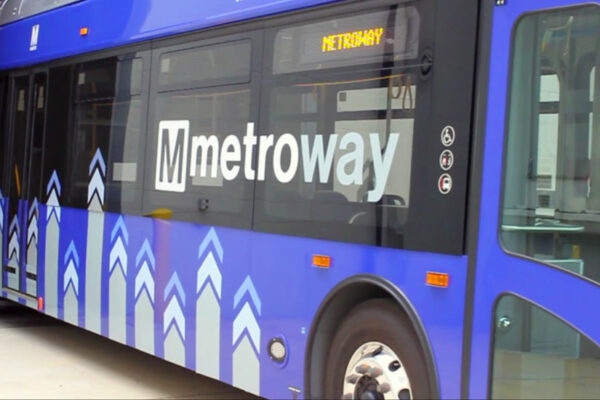
When Metroway, the region’s first rapid bus transit line, launched in 2014 it was hailed as the future.
Dedicated lanes, more frequent service, covered stations, and bigger, newer buses along a 4.5-mile route connecting Arlington and Alexandria would boost bus ridership in sections of both jurisdictions that were rapidly developing.
The price tag was big — more than $42 million, split nearly evenly between Arlington and Alexandria — but officials believed it was worth it and could have the added benefit of revving up rapid bus transit elsewhere in the D.C. area.
“A lot of people will be looking to this project as a test concept to find out what lessons they can learn from it,” said Eric Randall, a senior transportation engineer at the Metropolitan Washington Council of Governments (MWCOG), at the time. “It offers us an opportunity to apply some concepts for the first time — things like off-board fare collection, a design of bus stops with higher platforms and custom design shelters, a new branding and frequency of buses.”
It’s now 2021, seven years since Metroway’s launch, and it seems like a good time to ask the question: what have we learned from Metroway, the region’s first rapid bus transit?
Despite less-than-stellar ridership numbers and outside factors, rapid bus transit with dedicated infrastructure remains a worthy investment, according to local officials and public transportation advocates.
“I live in Alexandria and take Metroway monthly, from my perspective as a user, I think it’s a success,” Randall told ARLnow earlier this fall. He remains a transportation engineer with MWCOG.
“[Metroway] is doing what it’s supposed to be doing,” said Lynn Rivers, Arlington County’s Transit Bureau Chief. “Which is getting people out of their cars and onto the transit lanes.”
“Metroway is great,” said Sustainable Mobility for Arlington founder and Arlington Transportation Commission chair Chris Slatt . “It’s fantastic to have an example in Arlington of a dedicated space for transit. We really want to make transit time competitive with other ways to get around… and I think it does that.”
What’s more, the county is investing further into the needed infrastructure. In September, the county unveiled designs to extend the Transitway by an additional five stations and 1.1 miles so that it connects with the Pentagon City Metro station (not to mention areas close to Amazon’s new HQ2). While some advocates expressed their frustration about the lack of community engagement on street designs, their complaints were not necessarily about the concept of rapid bus transit or Metroway.
The extension is costing nearly $28 million, though most of it will be financed by the state and the Northern Virginia Transportation Authority. Arlington itself is spending about $1.8 million, according to Rivers, which is only about 6% of the project’s total cost.
Construction on the first segment is expected to start in the winter of 2022 with completion in late 2023.
That’s not to say there haven’t been challenges. Off-board fare collection, even though it was promised, has not been implemented yet. There’ve been sightings of confused motorists, as reported by ARLnow readers, driving their cars the wrong way in the dedicated bus lanes, despites signs and marked roads. Ridership hasn’t been as high as perhaps expected, leading to 2016 reports that shutting it down was being considered.
For that, the lack of steady progress in terms of development at Potomac Yard and issues with opening the Metro station there are being blamed.
“Certain forecasts way back when were perhaps based on more optimistic assumptions in terms of development [in Potomac Yard],” admitted Randall.
But rider numbers have grown fairly consistently since the route debuted in 2014, and reached an average of about 2,600 passengers on weekdays in 2019 according to WMATA data.
Comparing this to other Arlington bus routes, the 16G that travels from Columbia Pike to the Pentagon City Metro — without dedicated lanes — peaked at about 3,000 average weekday riders in 2014 before dropping down to about 2,160 riders in 2019. The 10A, which runs from Alexandria to the Pentagon, had nearly 1,800 average weekday riders in 2019.
Of course, the pandemic drastically cut those numbers, as they did for all regional public transportation. In 2020, there were only 669 Metroway riders on average on weekdays and 530 on average through the end of this September.
However, Metro did increase the frequency of the service in September, so now a bus arrives every 12 minutes on weekdays and 20 minutes on weekends from 7 a.m. to 9 p.m., in a bid to encourage ridership.
Officials say that the current low ridership numbers does not change at all their plans for Metroway or completing the Transitway extension. Rivers notes that Metroway is “holding its own” in terms of ridership and fully expects to rebound to 2019 numbers and beyond.
“This is just like a pendulum. It may be swinging a little low right now, but we absolutely believe it’s going to go back up again,” said Rivers. “This kind of infrastructure, you can’t just put it overnight. There’s no reason for us to stop at this point.”
This is the first of a four article series on the bus rapid transit system in Crystal City. It was funded by and first published to the ARLnow Press Club.

